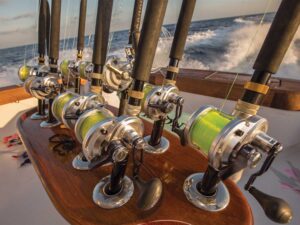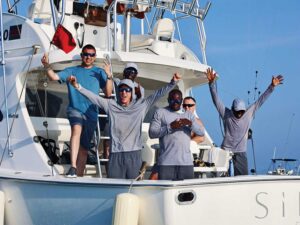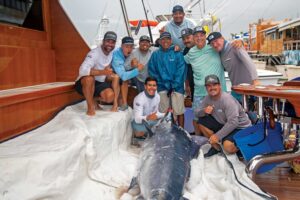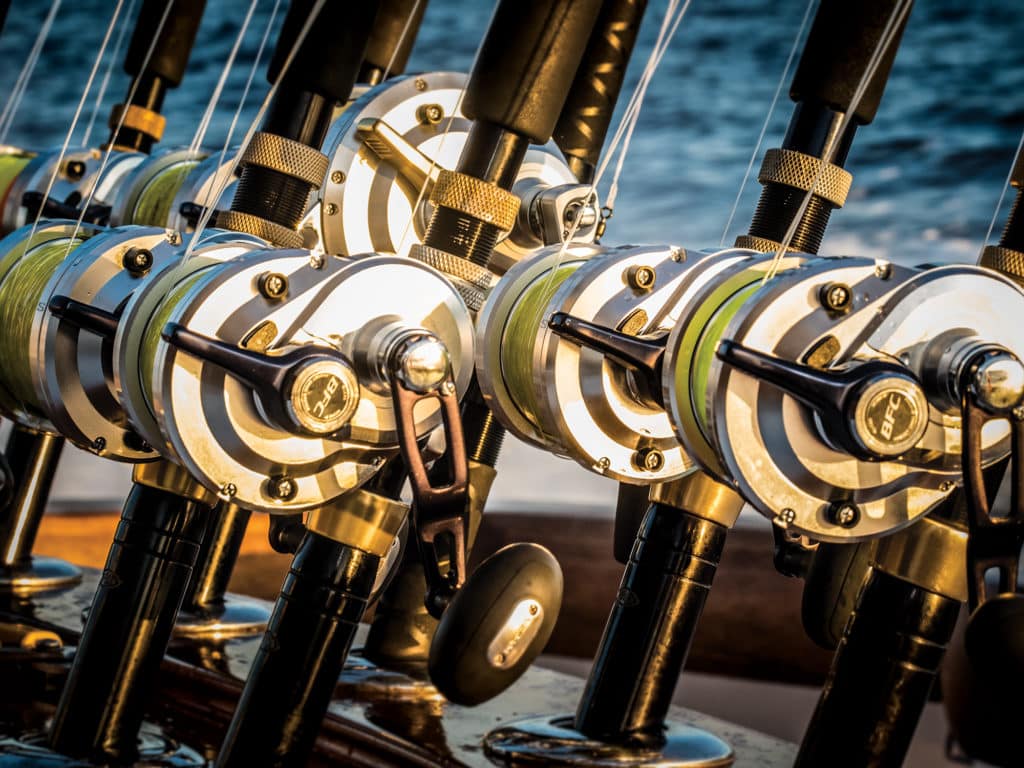
Do you ever wonder how some tournament teams post staggering numbers and consistently find themselves at the top of the fleet? It’s simple: They focus on catching more than one billfish at a time by turning a single into a double, or a double into a triple or quad. Sailfish, white and striped marlin, and even small blue marlin often feed in small packs, so your chances of a second, third or even fourth fish go way up if you can keep fishing after the first bite. From the helm to the cockpit, these techniques will help you fly more release flags or light up the leaderboard in your next tournament.
Prep for Success
The first step in getting multiple bites is 100 percent mental, according to Capt. Rhett Bailey aboard Intents, a 62-foot Viking home-ported in Palm Beach, Florida. “You have to always think there is more than one fish back there in the spread when you get a bite,” he says. “If you start by thinking about multiples, it’s easier to make it happen.” Whether he’s in a sailfish tournament in Florida, fishing the FADs off the Dominican Republic or chasing baitballs under frigate birds down in Isla Mujeres, Mexico, Bailey is always thinking about the next bite, not just the first one.
And while it may seem obvious, in order to catch more than one, you have to keep the baits in the water. Experienced pros will turn the boat in the direction of the first bite, clearing only the parts of the spread that absolutely must come in to avoid getting tangles. But as soon as the dredges, teasers and baits can be replaced in the spread, they are immediately redeployed to keep the spread intact. It’s been said before, but it bears repeating: No one ever caught a double- or tripleheader without a second or third bait in the water.

Crew talent is another key factor. As an angler, pay attention to what’s going on and listen for advice from the mates and captain while you watch your bait like a hawk. Don’t get distracted by someone else’s teaser bite or the greyhounding marlin in the distance, or you will miss the fish that sneaks in and catches you off guard. And if you do miss one, don’t just troll a ballyhoo head as the boat makes its circle; clear your line and be ready to fire out a fresh bait the instant a mate hands you a rod.
Keep your head on a swivel and be ready to move around the cockpit too. Slow is smooth, and smooth is fast.
And when you do hook up, don’t worry that the line seems to be pouring off the spool at an alarming rate as the boat continues its forward movement; don’t try to increase the drag to slow a fish that’s speeding away. Sails and small marlin rarely have the horsepower to completely dump all the line from a 20- or 30-pound-class reel. Let the rod and the drag do the work. As the captain circles around on the fish, you’ll be able to regain the line just as quickly. Most pros gear up for the dead-bait trolling with similar tackle: 7-foot rods with a little whip in the tip paired to high-speed conventional reels, with the Shimano Talica BFC 20 and Tyrnos 20 being favorites in the fleet. Main lines are usually 25- to 30-pound-test, with 50- to 80-pound-test fluorocarbon wind-on leaders and 6/0 to 8/0 nonoffset circle hooks getting the nod on most days. Prep a few dozen chin-weighted ballyhoo, and it’s time to go fishing.
Lighting Up Los Sueños
If you want to do well in the Pacific, fishing against some of the best dead-bait teams in the world that concentrate on multiple fish is critical for success. Tyler Andresen has captained Jaruco, a 68-foot Weaver, for four years, and they have consistently been one of the teams to beat in the highly competitive Los Sueños Signature Triple Crown. “I grew up in the Northeast, fishing out of Martha’s Vineyard and Cape Cod,” he says. “When we were tuna fishing, we would keep going in a straight line after we got a bite to try and hook a few more, but we really didn’t start turning on fish until we came to the Pacific.” He learned this cardinal rule quickly: If you want multiple bites, you have to keep the baits in the water as long as possible, and that means turning the boat after the first bite.
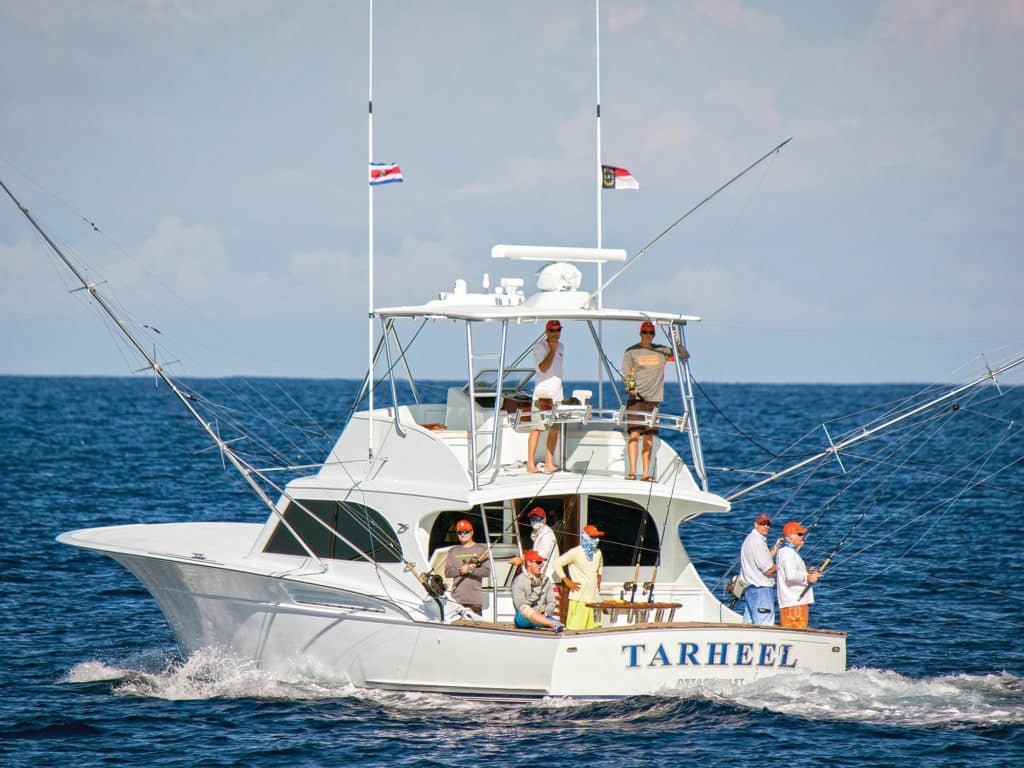
“Let’s say we get a left-rigger bite — I will start turning to the left to try and keep that fish on the inside of the turn,” Andresen says. “We’ll clear the bridge teaser and the dredge on that side and get the angler set up to fight the fish. We’ll reset everything as quickly as we can by moving the left flat up to the left rigger and get a new bait put out in the left-flat position. We’ll also drop the inside dredge back in the water and maybe keep it a little short. We will usually clear the bridge teaser on that side and get it in the boat. I don’t like it hanging from the rigger where it could get caught in the line as the fish is jumping.” Andresen prefers to make two full turns around a hooked fish — if possible — before the boat clears the spread and gives chase in reverse. He also likes to circle back around to where the first bite occurred, unless there are birds or bait on the surface around him. “Our guys usually hold the rods or the line all the time,” Andresen says, “using just enough thumb pressure to keep the line from creeping out. We fish every day like it’s a tournament.”
Carolina Whites, Mexican Sails
Off Oregon Inlet, North Carolina, the navy-hulled Bi-Op-Sea, a 59-foot Spencer, is a frequent sight on the rip. At the helm is Capt. Jesse Granitzki, one of the East Coast’s most consistent charter and tournament skippers. One reason for his success is in his ability to move the boat to get additional bites. “When you make that first turn in the direction of a hooked fish, the inside long rigger is probably the most important — that’s the one that will be closest to the fish that’s already hooked,” he says. “If we got a bite on the left-long rigger, and we’re turning in that direction, the first thing we’ll do is pop the right long out and switch it over to the left long so it stays as close to the hooked fish as we can.” If a fish jumps over a line, the crew will clear it to prevent a tangle and then redeploy it as fast as possible.

Another skill a successful team must master is the ability to handle doubles and triples from the helm. “Let’s say you have one fish that’s closer to the boat but deep, and one that’s farther away but up on the surface and jumping. Rather than backing down on the deep fish, I will drive away from it and make a turn around the one that’s jumping,” Granitzki says. “When you do that, it gives you a better angle on the deep fish, and they’ll usually come up while you’re driving toward the one that’s on top.” Sometimes, it’s possible to get the release without clearing any of the lines or teasers, in what he calls a “drive-by,” just by circling in tight on the fish going forward.
One thing you won’t find Granitzki doing is just sitting in the middle of a multiple hookup as the fish spread out in different directions. He will pick one and give chase.
Granitzki is also intimately familiar with the sailfish off Isla Mujeres. “Many of the same principles apply when we’re fishing down in Isla,” he says. “We want to keep the baits out as long as possible and get them back out quickly after we release a sail. Sometimes we’ll free-spool baits when we pass over fish marks on the sounder, which is something we usually don’t do at home in North Carolina.” If the sails are tight on the baitballs, it requires more of a team effort between the anglers and captain. “We’ll start by driving around a baitball to see if the sails will come after our baits, but if not, we’ll crank up the inside dredge and teaser and try to skip the inside-rigger bait through the baitball. If that doesn’t work, I’ll have an angler free-spool the bait right down through the ball. It takes a lot of visual interaction: I’m telling them to crank it up, jig it a little or drop it back, but we can usually get bites that way,” he says.
Head South: Florida Sails and Dominican Marlin
Bailey’s program aboard Intents centers solely around dead-bait trolling, not live-baiting. With that laser focus, he’s able to hone his team’s skills. “One thing I’ve found is that I’m not circling as hard on the bite as I would have done a couple years ago,” he says. “We’ve found that if there’s good light and you can see the bite, you’re actually better off in an easy turn so the fish aren’t over in the middle of a tight circle. Sometimes we’ll only make a half-turn to get the sun where we can see the fish.” He points out that another issue with a hard turn is that the lines can become crossed and tangled. “I may have an angler dump a ballyhoo back into the spread if we mark bait; if you’re circling hard, it’s difficult to keep that line from tangling,” he says.

Bailey takes those same strategies with him when fishing the FADs off Casa de Campo in the Dominican Republic. Multiples are more often the order of the day with the small blues and whites around. “It’s almost never a single there,” he says. “On our best day this past year, we were 11 for 16 and saw 20. We had quads hooked twice, with a fifth fish on the bridge teaser.” The tackle gets upgraded to Tyrnos 30s with Spectra backing for a little additional insurance, but rarely will a fish completely spool a reel. “If an angler freaks out, I’ll ask them to let me see the reel and gauge which fish we need to chase. If you just stay calm, everything usually works out fine,” he says. Bailey does point out that the captain needs to maintain situational awareness; it’s easy to make an aggressive turn on a blue one and become entangled in a FAD.
Prospecting for Bills
The technique of free-spooling a bait so it sinks deep past the dredge, then retrieving it in a controlled manner back to the boat is known as prospecting, and it’s a flat-out deadly tactic. Quite often there are fish hanging deep out of sight of the captain and crew as they shadow the dredge. A ballyhoo imitating a crippled member of a baitball past their noses is usually too much for them to resist.
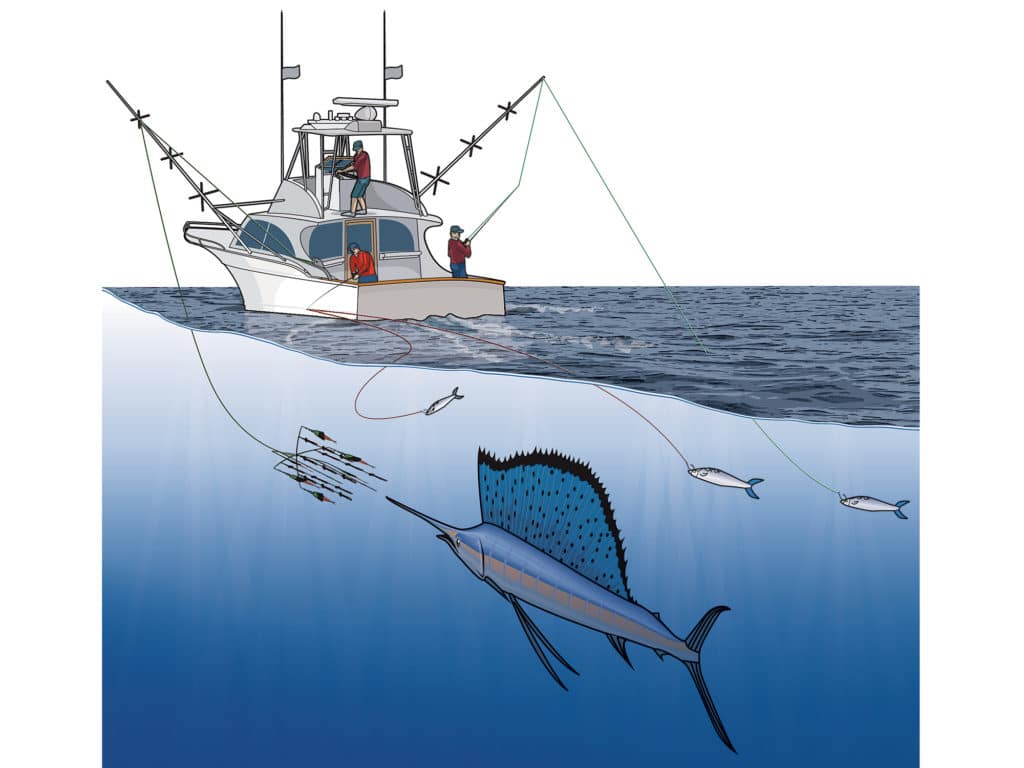
“We prospect all the time,” Bailey says. “It’s a very important part of our fishing. My anglers are die-hards who will stand there in the corners of the transom and do it all day long, just like pitching a Zara Spook and retrieving it back to the boat.” And he says if you’re not getting tangled in the dredge from time to time, you’re not getting the bait close enough to count. “Flip the bait forward of the dredge so it has a chance to get a little deeper and free-spool it back until it’s just past the long-rigger baits,” Bailey says. “Then engage just enough drag so that you can gain line; that way, you can go right back into free-spool if a fish bites you on the retrieve.” Most bites will be on the drop-back, and the angler will notice the spool suddenly begin to speed up, signaling that a fish has grabbed the bait and begun to swim away from the boat. Let the fish eat for a few seconds, then ease the drag up.
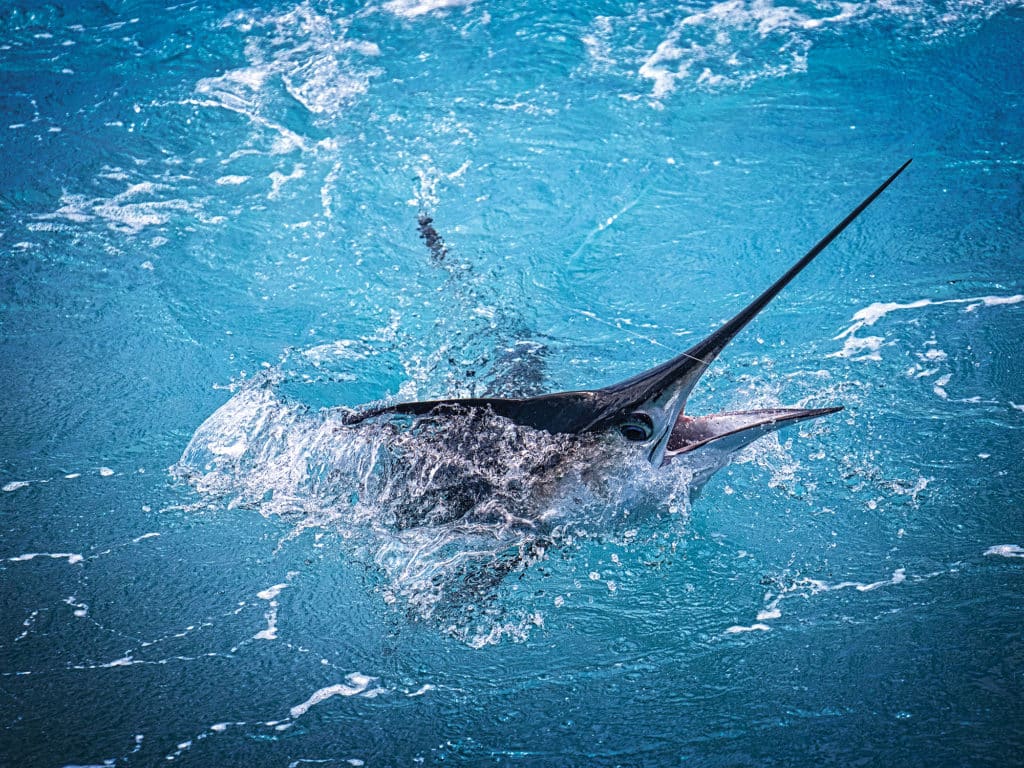
In North Carolina, Granitzki will occasionally have his anglers prospect a bait off the dredge, especially if there is a lot of fish in the area or if he’s getting good marks on the sounder. “We’ve got great anglers when we tournament fish, and you can pick up another bite or two that way,” he says. If he raises a fish on a teaser that disappears in the spread, he’ll often have his mate bump the dredge up a few feet to encourage the marauder to switch over to a bait. In the Pacific, Andresen doesn’t prospect much at all. “When I first got here, I was told that it didn’t work as effectively as in other places,” he says. “And our anglers were still getting adjusted to this style of fishing, so it was better to just have them concentrate on their baits.”
Making Magic with Multiples
Watching two, three or more marlin or sailfish erupt from the water in different directions is just about as exciting as it gets in all of sport fishing. When both captains and anglers concentrate on producing multiple bites rather than just that first nibble, your catch rates will soar and you may be able to produce a tournament-winning fish.
